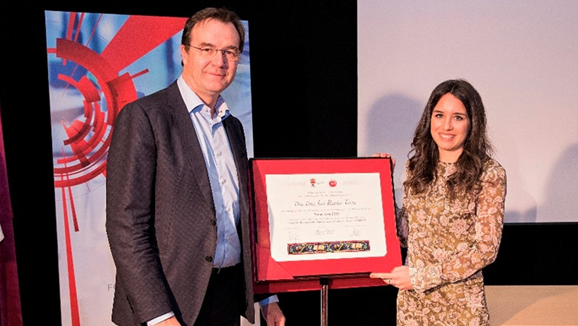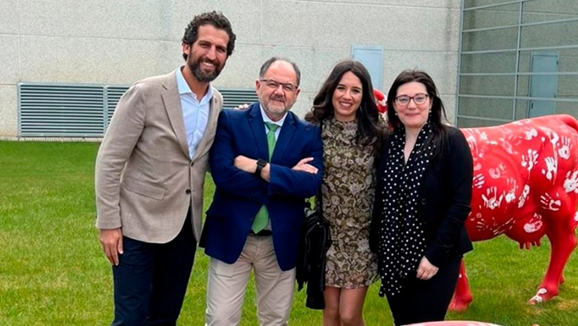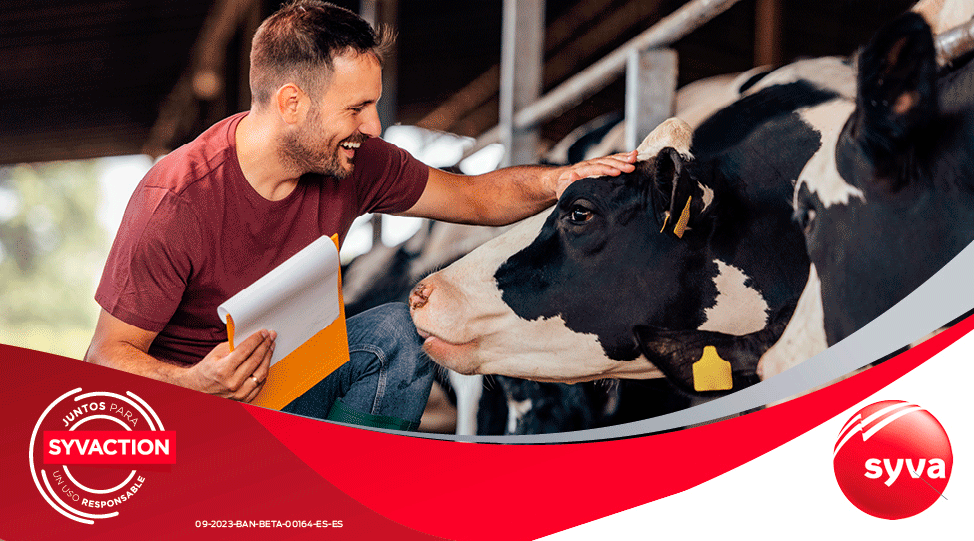Challenges facing the pig industry in the face of PRRSV
Inés Ruedas: “There are advances in the control of PRRSV, but there is still a long way to go and many unknowns regarding the immunopathogenesis of this virus”.
Elena Martín 18/07/2023 [Translated from: www.interempresas.net/porcino/Articulos/]
Researcher Inés Ruedas Torres, currently beneficiary of a “Margarita Salas” contract from the Spanish Ministry of Universities, which allows her to develop her research in the UK, graduated in Veterinary Medicine from the Complutense University of Madrid in 2017 and obtained her PhD from the University of Cordoba in 2022. Her thesis was developed within the research group “Animal Pathological Anatomy (AGR 137)” of the Department of Comparative Anatomy and Pathology and Toxicology of the Faculty of Veterinary Medicine (University of Cordoba), which is responsible for the study of the pathogenesis of infectious diseases of domestic animals, mainly pigs (UCO-PIG group). Her doctoral thesis project was funded by the Ministry of Economy and Competitiveness, which was awarded in 2017 to her research group, led by the researcher Librado Carrasco. This work has recently been awarded the “Syva 2022 Prize for the best doctoral thesis in Animal Health”, for being, according to the tribunal, a fundamental advance in the knowledge of the pathogenesis of the Porcine Reproductive and Respiratory Syndrome Virus (PRRSV) and a reference for future studies. PRRSV is one of the pathogens with the greatest impact on the pig sector. In addition to affecting the reproductive system in breeding sows and the respiratory tract in young animals, it is often associated with other secondary diseases, which is why it has become the health problem that generates the greatest economic losses in the pig industry worldwide.
How did you decide on the topic of your thesis?
I decided to do the thesis focusing on PRRSV because despite the fact that forty years have passed since its emergence, this virus is still one of the pathogens with the greatest economic impact in the pig sector, due to the lack of fully effective control tools. This, together with the re-emergence of virulent strains, has increased the interest of the pig industry and the scientific community in the study of the immunopathogenesis of the different strains of the virus. That is why I decided to carry out the thesis focused on the study of the immune response against PRRSV, specifically, against the European genotype of PRRSV commonly known as PRRSV-1), the most predominant in Europe.
One of the main characteristics of this virus, regardless of its virulence, is its ability to modulate the host immune response. Thus, PRRSV is able to regulate several biological processes of the immune system to favour its distribution, replication and latency in the organism. In my doctoral thesis entitled
“Regulation of the immune response in strains of different virulence of PRRSV-1”, the processes that may be modulated during infection with PRRSV in target organs of infected piglets are studied in depth, carrying out a comparative study between two strains of different virulence of PRRSV-1, one of low virulence, strain 3249, and another of high virulence, strain Lena.
What are the most common effects of PRRSV in pigs?
PRRSV is also characterised by the great variability of clinical signs it produces in infected animals. The disease can range from asymptomatic or subclinical disease to severe, even devastating reproductive and respiratory disease, as in the case of virulent strains of PRRSV, where on-farm mortality can reach 100 %.
Low virulence strains of PRRSV have a reproductive form, characterised by abortions, premature farrowing, m u m m i f i e d foetuses, etc., and a respiratory form, which mainly affects transition and fattening pigs and causes coughing, nasal discharge or fatigue, resulting in growth retardation and affecting average daily gain.
When we are facing an infection by virulent strains, such as the one commonly known in Spain as Rosalia strain, the clinical picture is much more acute, causing high fever in infected animals and increased mortality at all stages of growth, even in breeding sows. Furthermore, infection with virulent strains of PRRSV is frequently associated with the presence of secondary bacterial infections that worsen the clinical picture.
What lesions can we find in affected animals?
Low virulence strains usually do not produce striking lesions in infected pigs, in the worst case, these animals develop interstitial pneumonia characterised by enlarged lungs, rubbery consistency and pale colouring.
When a highly virulent strain is present, lesions are more intense, with consolidation foci also appearing in the lungs, mainly in the cranial lobes of the lungs due to the presence of secondary bacterial infections. Another striking lesion in animals infected with virulent strains is the disappearance or atrophy of the thymus, the organ responsible for the development and maturation of T-lymphocytes, greatly impairing the immune system. In some outbreaks in China caused by virulent strains of PRRSV-2, haemorrhages in the heart, lymph nodes and kidney have also been reported.

César Carnicer and Inés Ruedas at the awards ceremony held at the Syva facilities (León) on 25 April 2023.
In your opinion, what are the most important challenges facing the sector in the face of this virus?
Due to the high genetic diversity of PRRSV virus and its potential for recombination between endemic and emerging strains, the main challenge facing the pig sector in the face of this virus is the emergence or re-emergence of new virulent or highly virulent strains, which, as we have seen, have devastating health and economic consequences on farms. In addition, because animals infected by this virus are more susceptible to opportunistic bacterial infections, the use of antimicrobials for their control is increasing, and with it the possible emergence of resistance.
The immunomodulatory capacity of PRRSV allows it to “escape” from the host immune system, which, together with genetic variability, means that currently available commercial vaccines only induce partial protection against the disease.
What role does biosecurity play in the prevention of PRRS virus and how is it usually implemented on pig farms?
I believe that preventing the spread of the virus within and between pig farms is a critical pillar of the disease control programme. Generally, and not only for the prevention of PRRSV, external biosecurity measures that prevent the introduction of pathogens on the farm must be applied first. In this respect, biosecurity measures are used for the management of restocking, such as the placement of quarantine areas, e.g. semen supply, animal transport vehicles, loading and unloading docks, etc. When these external biosecurity measures fail, internal biosecurity measures must be effective to prevent the spread of the virus between the different growth stages and the different houses of the farm. Among the internal biosecurity measures that are implemented are the frequent change of needles, change of gloves, clothing and footwear in the different houses and a correct management of carcasses. In this sense, it is essential to use an all-in/all-out system, which allows for good cleaning, disinfection and management of the facilities.
It is important to mention that these measures must be accompanied by continuous training in biosecurity, both for internal and external personnel involved in the management of the farm, as well as for visitors, so that they are aware of the importance of the protocols carried out on the farm.
At a general level, are there any recent advances in the control of this disease? Which ones?
Yes, there have been recent advances in the control of PRRSV, however, there is still a long way to go and many unknowns to be solved regarding the immunopathogenesis of this virus. For example, new, more sensitive and rapid diagnostic methods have been developed to detect the presence of the virus in pigs, allowing early identification of the infection and a rapid response to control its spread. In addition, increased attention is now being p a i d to biosecurity measures to prevent entry and spread.
The use of vaccines is essential for the control of PRRSV, as their use reduces the clinical signs of the disease and the circulation of the virus on the farm. However, the commercial vaccines currently available do not produce a 100% response against the different strains of PRRSV. In this sense, recent advances have allowed the identification of potential proteins/markers of interest, which are involved in the immunity against PRRSV, as well as the identification of vaccine adjuvants that can reinforce the immune response against this pathogen. These advances are aimed at the design of new generation vaccines that are safe, effective and capable of producing cross and long-lasting immunity against the different strains of PRRSV. In addition, the use of gene editing technologies to develop PRRSV-resistant pigs is currently being explored. Importantly, the scientific community, pig industry organisations and producers are working together to share information and data to improve PRRSV control practices.
Are there regional differences in the prevalence and management of PRRS virus and how it is implemented on pig farms?
As PRRS is not a notifiable disease, nor is it subject to control measures by the European Union, there are no reliable prevalence data for t h e different countries. In general, countries with a larger census, such as Spain or Germany, have a higher prevalence of PRRSV. Countries such as Denmark have lower prevalences, partly due to the strict biosecurity measures, both internal and external, applied in this country.
In addition, these differences are also due to the different vaccination protocols and vaccines applied.

Photo 2. Same day as the award ceremony at the entrance to the Syva facilities. From left to right, Jaime Gómez Laguna (thesis supervisor), Librado Carrasco (thesis tutor) and Irene Rodríguez Gómez (thesis
supervisor).
What recommendations would you give to pig producers to reduce the risk of PRRS virus infection on their farms?
It is difficult to specify general recommendations for the control of PRRSV, because each farm has different characteristics that make the possible measures to be applied vary from farm to farm. However, I would like to emphasise the application of biosecurity measures. The main risk of PRRSV introduction in farms is through replacement sows and semen, so monitoring their health status at farm entry would greatly contribute to reduce this risk. Advocacy for the correct use of quarantines, proper and biosecure loading and unloading bays, as well as the application of strict rules for workers and visitors, can be key to reducing the risk of PRRSV introduction. In addition, thorough record keeping of all biosecurity and health related activities on the farm is essential for proper management and evaluation of control protocols.
In this sense, especially due to the recent appearance of virulent strains in Spain, I believe it would be convenient to create communication tools between veterinarians and producers to alert of the possible presence of these strains in an area.
What is the current focus of your work, are you still investigating these aspects?
I currently have a post-doctoral contract called “Margarita Salas”, which allows me to continue my research career at a research centre in England, the United Kingdom Health Security Agency (UKHSA). This centre has been a reference point during the management of the crisis caused by the SARS-CoV-2 virus, as well as for the development of vaccines against the disease it causes. In addition, other emerging viral diseases of major public health importance are being studied at the centre. In particular, my work in the UKHSA pathology group focuses on the study of the immune response in animals infected with these diseases, using digital pathology tools that can be applied in future projects related to PRRSV.
In addition, I do not lose contact with my research group at the University of Cordoba, contributing and collaborating remotely in some research projects and contracts with companies, mainly related to the immunopathogenesis of different swine diseases such as those produced by PRRSV, porcine circovirus type 2, porcine epidemic diarrhoea virus, etc.
What has winning the Syva Award meant for you at all levels?
Winning the Syva award has been a truly transformative experience at all levels of my life. It has been an enormous recognition of my work as a researcher, as it is undoubtedly the most highly valued prize in the field of animal health within the Spanish scientific community. I t is not only a recognition for me, but also for my whole group (UCO-pig), because my work is the sum of everything that has been done during the previous years, long before I came to the department.
Personally, it has been an incredible emotional boost, as it has given me a great deal of confidence in my abilities and my potential to continue to grow and develop as a researcher.
On a professional level, winning the prize has opened many doors for me, increased my visibility in the research world and generated more interest in my work. I believe that the Syva prize also serves as an important endorsement of my career and can be a key factor in obtaining future contracts and funding for future research. This award has also meant “strengthening ties”, not only with the company Syva, but also with the other winners (Daniel Rodríguez Martín and María Canive Ruiz) and the heads of the research groups, who work like our group in the knowledge and search for solutions to combat animal diseases.
From here I would like to thank the panel that awards this prize, Syva and the University of León, who have considered me worthy of this important distinction and who, with their work, give value to research work, supporting and motivating young people like me to continue on this exciting path. I would also like to take this opportunity to thank my thesis supervisors, Irene Rodríguez Gómez and Jaime Gómez Laguna, and my tutor Libado Carrasco, for their invaluable help during the four years of the project. Without them it would not have been possible.



